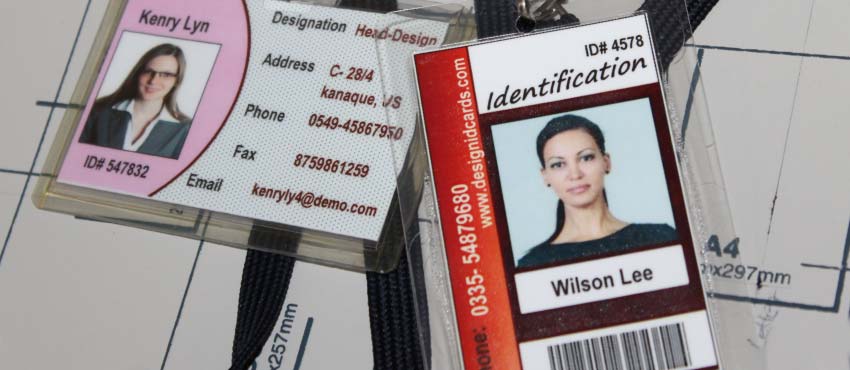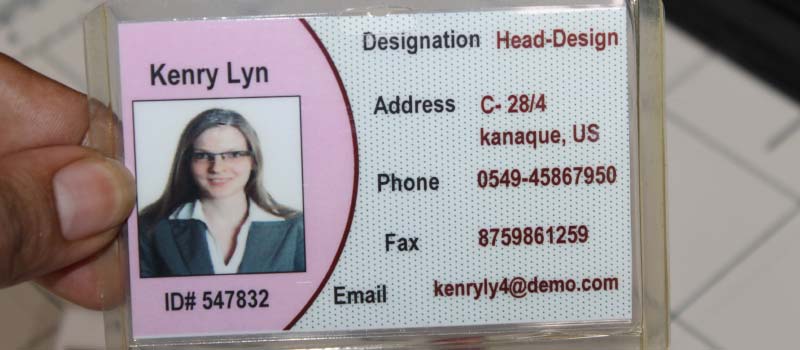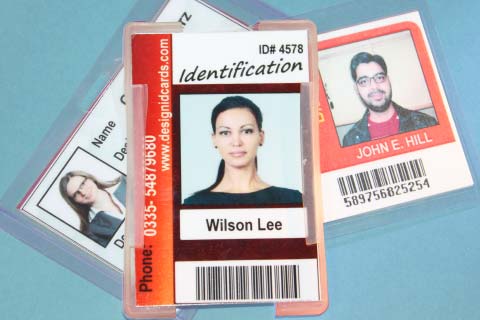Related Article:
ID Badge Design: Adding Photos and Included Information
ID Badge: Aspects, Usage Benefits, and Importance
ID Badges Maker for Mac: Images, Design Elements, Badge Types, and Import Data
ID Badge Maker for Mac: Features, Working, and Custom ID Badges Creation
ID Badges Maker for Mac: Usage, Integration, and Data Security
ID Badges Maker for Mac: File Formats, Features, and Level of Support
ID badges play a crucial role in identifying individuals within an organization, ensuring security, and enabling access control. They are commonly used in various settings such as corporations, government agencies, educational institutions, healthcare facilities, and many others. The size of an ID badge is determined by factors like the available space for information, the desired visibility, and any additional features that need to be incorporated.
⯁ Standard ID Badge Sizes: The most widely used standard ID badge size is the CR80 format. CR80 refers to the dimensions of 3.375 inches (85.6 mm) in width and 2.125 inches (54 mm) in height, which is approximately the same size as a credit card. This size is preferred due to its compatibility with existing card printers and accessories.
⯁ Other Common ID Badge Sizes:
-
a. Oversized Badges: Some organizations prefer oversized ID badges for better visibility and to accommodate larger fonts or additional information. Oversized badges may be around 4 inches (102 mm) in width and 3 inches (76 mm) in height, providing more space for customization.
-
b. Small Badges: In certain situations, where space is limited or a discreet identification method is required, smaller ID badges may be used. These can range from 2 inches (51 mm) to 2.625 inches (67 mm) in width and 1 inch (25 mm) to 1.5 inches (38 mm) in height.
-
c. Custom Sizes: Organizations with unique requirements or specific design preferences may opt for custom-sized ID badges. These sizes can vary significantly based on the organization's specifications and the capabilities of the printing equipment.
⯁ Badge Orientation: ID badges can be designed in either a landscape or portrait orientation, depending on the available space and the desired presentation of information. The CR80 format is commonly used in landscape orientation, with the width being greater than the height. However, portrait orientation can also be chosen based on the design and content layout requirements.
⯁ Thickness and Material:Apart from size, the thickness of ID badges is another important consideration. Standard ID badges are typically around 0.030 inches (0.76 mm) thick, which allows for durability without being too bulky. Thicker badges, such as 0.050 inches (1.27 mm) or more, can be used to accommodate additional features like embedded technology or for enhanced durability.
⯁ Specialized ID Badges: In some cases, specialized ID badges are used to serve specific purposes or provide additional functionality. These may include:
-
a. Proximity Cards: Proximity cards are ID badges equipped with embedded RFID (Radio Frequency Identification) or NFC (Near Field Communication) technology. They allow for secure access control and are often used in conjunction with electronic door locks or card readers.
-
b. Smart Cards: Smart cards, also known as chip cards, are ID badges that contain an embedded microprocessor chip. These cards can store and process data, enabling more advanced functionalities like biometric authentication or data encryption.
-
c. Holographic Badges: Holographic badges incorporate holographic images or elements for enhanced security and counterfeit prevention. These visually striking features provide an additional layer of authentication and can deter unauthorized duplication.
There are several types of ID badges available, each designed to meet specific needs and requirements. Here are the different types of ID badges commonly used:

-
Student ID Cards:
Student ID cards are used in educational institutions to identify students and grant them access to various campus facilities. These cards often include the student's photograph, name, student ID number, and sometimes their academic program or level. Student ID cards can also be linked to other systems like library access, meal plans, or transportation services.
-
Access Control Badges:
Access control badges incorporate technology such as magnetic stripes, smart chips, or proximity cards. These badges are used in conjunction with access control systems to regulate entry to specific areas or buildings. They allow authorized individuals to swipe or scan their badges to gain access, enhancing security and preventing unauthorized entry.
-
Visitor Badges:
Visitor badges are temporary badges issued to individuals visiting a facility for a limited time. These badges typically include the visitor's name, date of visit, and a "Visitor" label. They help identify and distinguish visitors from regular employees, allowing security personnel to easily recognize and monitor visitor activities.
-
Contractor Badges:
Contractor badges are similar to visitor badges but are specifically issued to contractors or third-party service providers who need temporary access to a facility. These badges may include additional information such as the contractor's company name, contact details, and duration of authorized access.
-
Photo ID Badges:
Photo ID badges are the most common type of identification badges. They typically include a photograph of the badge holder, along with their name, job title, and organization. Photo ID badges are effective for visual identification, enabling others to quickly recognize authorized personnel.
-
Event Badges:
Event badges are temporary identification badges issued to individuals attending conferences, trade shows, or other large-scale events. These badges typically include the attendee's name, organization, and event-specific details. Event badges help manage access control, identify participants, and enhance security during the event.
-
Medical ID Badges:
Medical ID badges are used in healthcare settings to identify healthcare professionals and staff members. These badges often include the individual's photograph, name, job title, and the name of the healthcare facility. In some cases, they may also indicate the individual's area of expertise, certifications, or emergency contact information.
-
Employee Badges:
Employee badges are standard identification badges issued to employees within an organization. They typically include the employee's photograph, name, job title, and company logo. Employee badges may also incorporate additional information like department, contact details, or security clearances, depending on the organization's needs.
-
Volunteer Badges:
Volunteer badges are issued to individuals who offer their services on a voluntary basis, such as in nonprofit organizations or community events. These badges help identify and acknowledge volunteers, providing them with access privileges or perks specific to their role.
-
Security Badges:
Security badges are specialized identification badges issued to security personnel. These badges often have distinctive designs, colors, or markings to clearly distinguish security personnel from others. Security badges may include the individual's photograph, name, badge number, and any additional certifications or credentials.
Important Note: It's important to note that the specific features and design elements of ID badges can vary based on organizational requirements, industry regulations, and security considerations. Choosing the appropriate type of ID badge depends on the intended purpose, level of security needed, and the information that needs to be displayed.
The Key Elements of a Good ID Badge Design
A good ID badge design encompasses several key elements that contribute to its effectiveness and functionality. Here are the key elements of a well-designed ID badge:

-
Clear and Visible Information:
The badge should prominently display the essential information required for identification. This includes the individual's photograph, full name, job title, and organization or department. The information should be legible, easily readable from a reasonable distance, and properly sized to ensure clarity.
-
Branding and Logo:
Incorporating the organization's logo and branding elements reinforces brand identity and consistency. The logo should be placed prominently on the badge, typically in a size and position that complements the other information. Consistent use of brand colors, fonts, and design elements helps strengthen the organization's visual identity.
-
High-Quality Photograph:
A clear and high-quality photograph of the badge holder is crucial for visual recognition and identity verification. The photograph should be positioned prominently on the badge, preferably in color, and of sufficient size to allow for easy identification. The image should accurately represent the individual's appearance and be regularly updated to maintain relevance.
-
Security Features:
Depending on the level of security required, ID badges may incorporate security features to deter counterfeiting and unauthorized access by any other person. These features can include holographic overlays, UV printing, microprinting, or other anti-counterfeiting measures. Such security features provide an added layer of protection and help ensure the authenticity of the badge.
-
Readable Typography:
Choosing clear, legible fonts is essential for ensuring the badge's readability. The font style and size should be selected carefully, considering both aesthetic appeal and practicality. Avoid overly decorative or intricate fonts that may compromise readability, especially from a distance. It's also important to ensure sufficient contrast between the text and the background for easy reading.
-
Hierarchy and Organization:
ID Flow is a dedicated ID card design software that offers The information on the badge should be organized in a logical and intuitive manner. Key details such as the individual's name and photograph should be placed prominently, with secondary information such as job title, department, and contact details arranged accordingly. Clear visual hierarchy helps users quickly identify and locate the necessary information on the badge.
-
Barcodes or QR Codes:
Incorporating barcodes or QR codes on the badge enables quick and accurate scanning for various purposes such as access control, timekeeping, or equipment tracking. The code should be placed strategically and designed to be easily scannable, ensuring efficient data capture and reducing the risk of errors.
-
Customization and Differentiation:
Depending on the organization's needs, the badge design can include customization and differentiation features. Color-coding or icons can be used to differentiate between departments, access levels, or roles. These visual indicators make it easier to identify individuals or groups quickly and enhance organizational efficiency.
-
Durable Materials and Finishes:
The choice of materials and finishes for the badge is crucial for durability and longevity. Opt for materials that are resistant to wear and tear, such as PVC, polycarbonate, or composite materials. Additionally, consider protective finishes like laminate or clear coatings to guard against scratches, fading, or water damage, ensuring the badge maintains its visual appeal over time.
-
Comfortable and Secure Attachment:
The badge design should include a secure and comfortable attachment mechanism, such as a lanyard, badge reel, clip, or cardholder. The attachment should be easy to use and reliable, ensuring that the badge remains securely in place during regular activities without causing discomfort or hindrance.
Summary: By incorporating these key elements into the design, an ID badge becomes an effective tool for identification, verification, branding, and security, promoting a professional and cohesive image while facilitating smooth operations within an organization.
